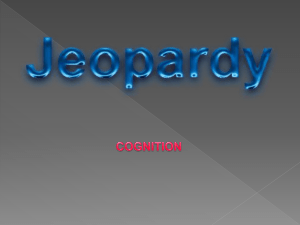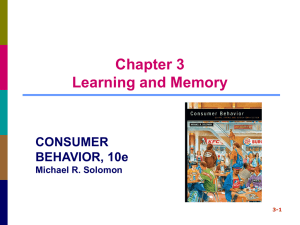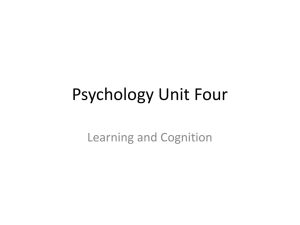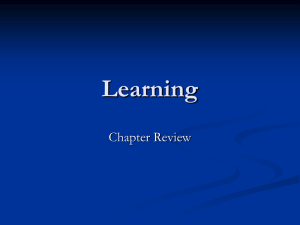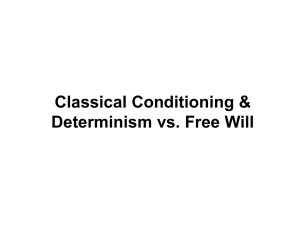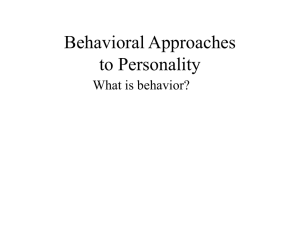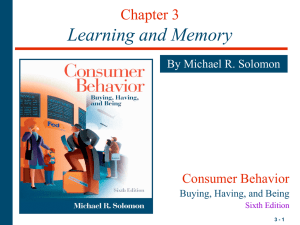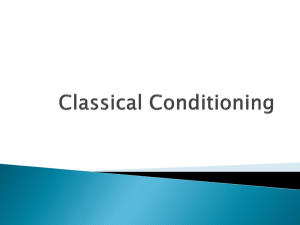conditioningreview
advertisement
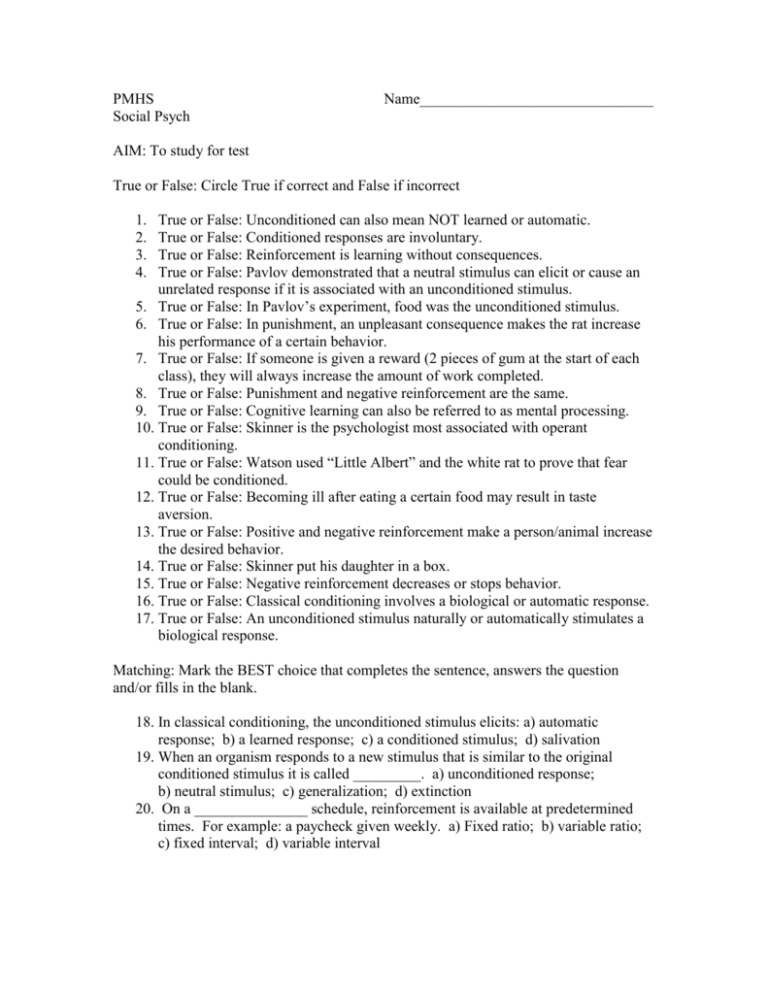
PMHS Social Psych Name_______________________________ AIM: To study for test True or False: Circle True if correct and False if incorrect 1. 2. 3. 4. True or False: Unconditioned can also mean NOT learned or automatic. True or False: Conditioned responses are involuntary. True or False: Reinforcement is learning without consequences. True or False: Pavlov demonstrated that a neutral stimulus can elicit or cause an unrelated response if it is associated with an unconditioned stimulus. 5. True or False: In Pavlov’s experiment, food was the unconditioned stimulus. 6. True or False: In punishment, an unpleasant consequence makes the rat increase his performance of a certain behavior. 7. True or False: If someone is given a reward (2 pieces of gum at the start of each class), they will always increase the amount of work completed. 8. True or False: Punishment and negative reinforcement are the same. 9. True or False: Cognitive learning can also be referred to as mental processing. 10. True or False: Skinner is the psychologist most associated with operant conditioning. 11. True or False: Watson used “Little Albert” and the white rat to prove that fear could be conditioned. 12. True or False: Becoming ill after eating a certain food may result in taste aversion. 13. True or False: Positive and negative reinforcement make a person/animal increase the desired behavior. 14. True or False: Skinner put his daughter in a box. 15. True or False: Negative reinforcement decreases or stops behavior. 16. True or False: Classical conditioning involves a biological or automatic response. 17. True or False: An unconditioned stimulus naturally or automatically stimulates a biological response. Matching: Mark the BEST choice that completes the sentence, answers the question and/or fills in the blank. 18. In classical conditioning, the unconditioned stimulus elicits: a) automatic response; b) a learned response; c) a conditioned stimulus; d) salivation 19. When an organism responds to a new stimulus that is similar to the original conditioned stimulus it is called _________. a) unconditioned response; b) neutral stimulus; c) generalization; d) extinction 20. On a _______________ schedule, reinforcement is available at predetermined times. For example: a paycheck given weekly. a) Fixed ratio; b) variable ratio; c) fixed interval; d) variable interval 21. A gambler at a slot machine operates on a ________________ schedule. This is one of the most effective in getting a person/animal to perform behavior. a) Fixed ratio; b) variable ratio; c) fixed interval; d) variable interval 22. An animal that is reinforced every fifth response is on a__________ schedule: a) Fixed ratio; b) variable ratio; c) fixed interval; d) variable interval 23. _________ discovered the principles of classical learning. a) Pavlov; b) Skinner; c) Bandura; d) Tolman 24. A stimulus or event that affects the likelihood that a behavior will be ______ is called reinforcement: a) repeated; b) decreased; c) stopped; d) all of the above 25. When shaping a rat or approximating, rewards to reinforce behavior should be given within ________________ of the rat performing the behavior. a) 25 seconds; b) 1 hour; c) 1 day; d) 1 week 26. The sound of a sizzling frying pan causes Ralph to salivate uncontrollably. The sound of the sizzling frying pan is a: a) unconditioned stimulus; b) conditioned stimulus; c) unconditioned response; d) conditioned response; e) neutral stimulus 27. An animal is placed in a cage and shocked. The next time the animal is placed in the same cage, it begins to show anxiety and attempts to flee the cage. The cage has become a(n)_________________. a) Unconditioned stimulus; b) neutral stimulus; c) conditioned stimulus; d) conditioned response 28. You had a car crash in a Jeep. Now you will never buy a Jeep again. ________ is occurring: a) extinction; b) positive reinforcement; c) generalization; d) punishment 29. A puff of air is blown into someone’s eye. The person blinks. What does the blink represent? a) Unconditioned stimulus; b) neutral stimulus; c) unconditioned response; d) conditioned response 30. Desired Behavior is underlined *Student yells and screams until rat touches white side of block. *Student gives rat a pat on the back when rat touches white side of block. These sentences describe the difference between: a) extinction and generalization; b) rewards and punishments; c) positive and negative reinforcement; d) Good and bad shaping Use the following examples to explain negative and positive reinforcement: I. Parents let you use the car when grades are high II. Parents will make you wash the car if grades start dropping slightly, so you can keep grades high 31. Negative reinforcement is making a person/animal perform a certain behavior by taking away stimulus or avoiding something unpleasant. Which is negative? a) I; b) II; c) both I and II; d) none 32. Positive reinforcement is making a person/animal perform a certain behavior by following the behavior with something pleasant. Which is positive? a) I; b) II; c) both I and II; d) none 33. Which is NOT an example of an involuntary action? a) mouth watering; b) heart beating fast when feeling anxious; c) eating from a dish of food; d) all above 34. If you stop presenting the unconditioned stimulus, the conditioned response lessens in strength. This process is called: a) extinction; b) positive reinforcement; c) generalization; d) punishment 35. Define the following: Neutral Stimulus Fixed Ratio Conditioned stimulus Fixed Interval Taste Aversion Variable Ratio Generalization Variable Interval Cognitive learning 36. What is the difference between operant and classical conditioning? Give an example for each. 37. What is the difference between punishment and negative reinforcement? Give an example of each. 38. Why is a variable ratio schedule the best way to reinforce learning? Give an example. 39. Name one thing you were able to get your rat to do and explain one positive and one negative reinforcement used on your rat. 40. How did Watson condition fear into Little Albert. Include NS, UCS, UCR, CS, CR and show extinction. 41. Define 4 schedules of reinforcement and explain an example for each. More and more questions Write whether the statement is Classical (C), Operant (O), Social (S), or Cognitive (CG) Conditioning ________ Dog jumps on people because every time she does, they pet her. ________ An athlete watches their coach shoot a foul shot to learn how to better use their legs. ________ A student is given money when they get good grades on their report card. ________A dog is afraid of newspapers because its owner always smacks him with rolled pages. ________ A rat memorizes a maze. ________ The sound of a sizzling frying pan makes Ralph salivate uncontrollably. ________ Child cries to make his parents change his diaper. ________ Child cries to make her parents buy her a toy. ________ A student smells baby wipes and thinks of rats because of using them with his pet rat for a month. ________ When students yell, “rat on the floor” in Social Psychology, almost everyone freezes and looks to help the situation. Write whether the following examples are avoidance or escape ________ Studying for this test, so you don’t fail ________ Teacher and parents yelling until you open your notes and study
